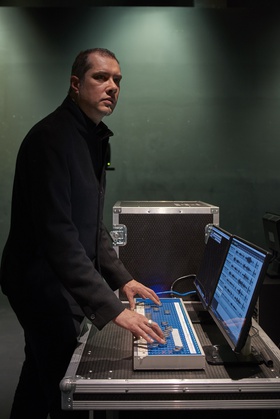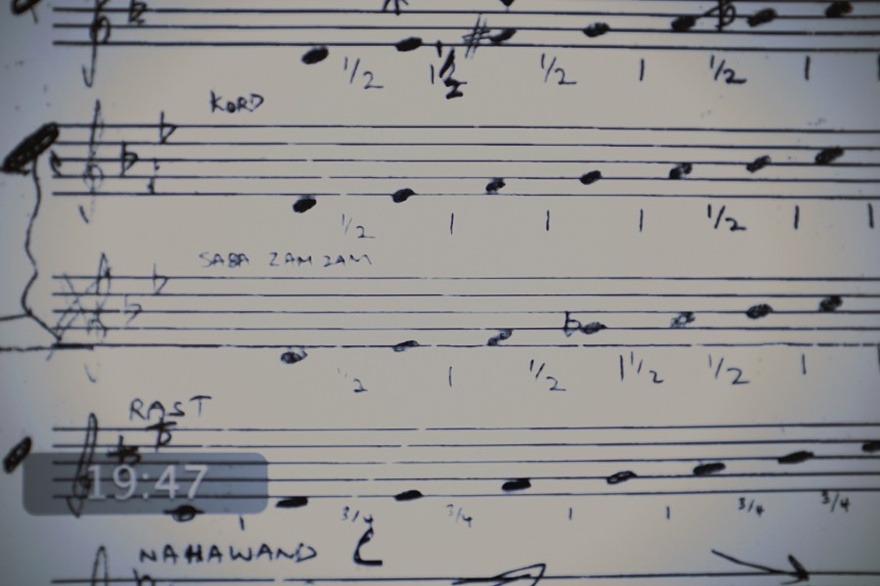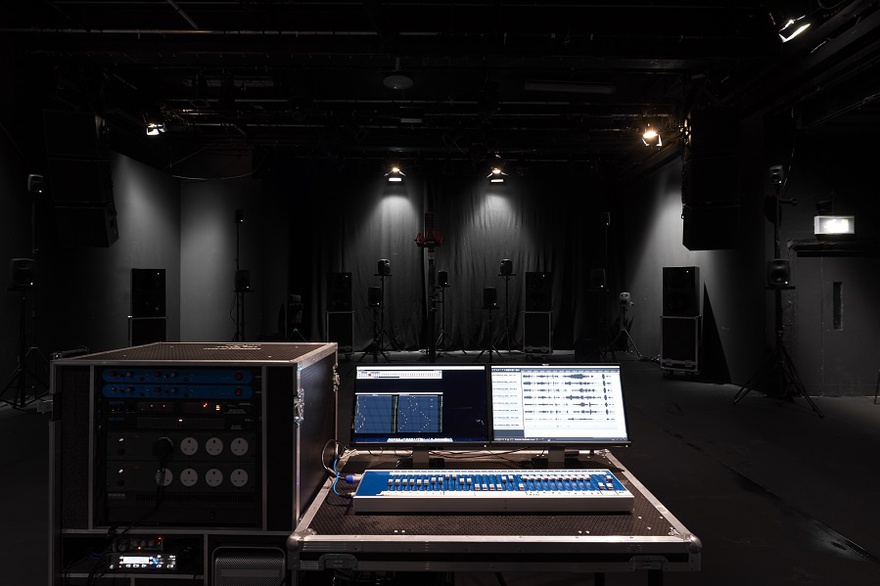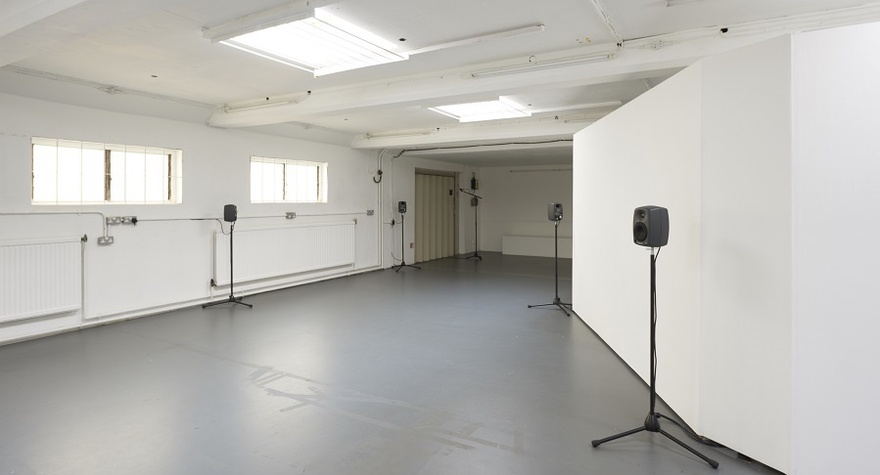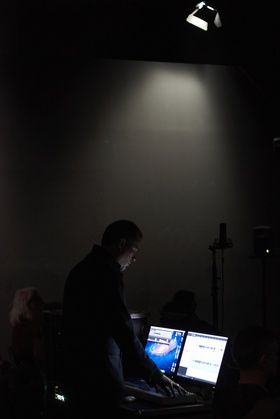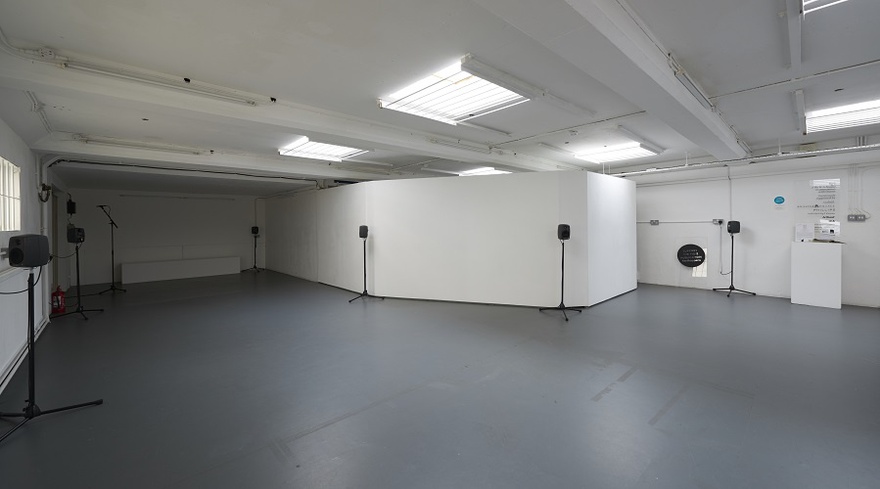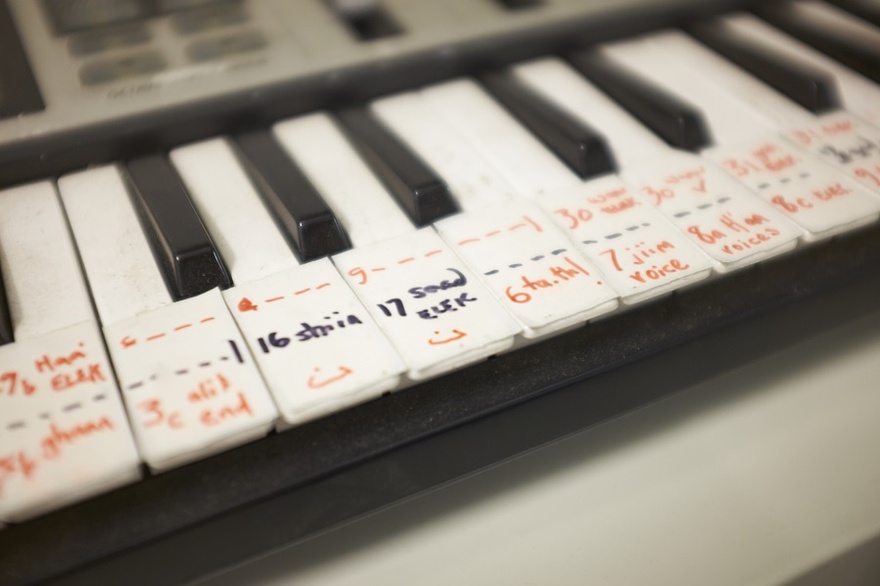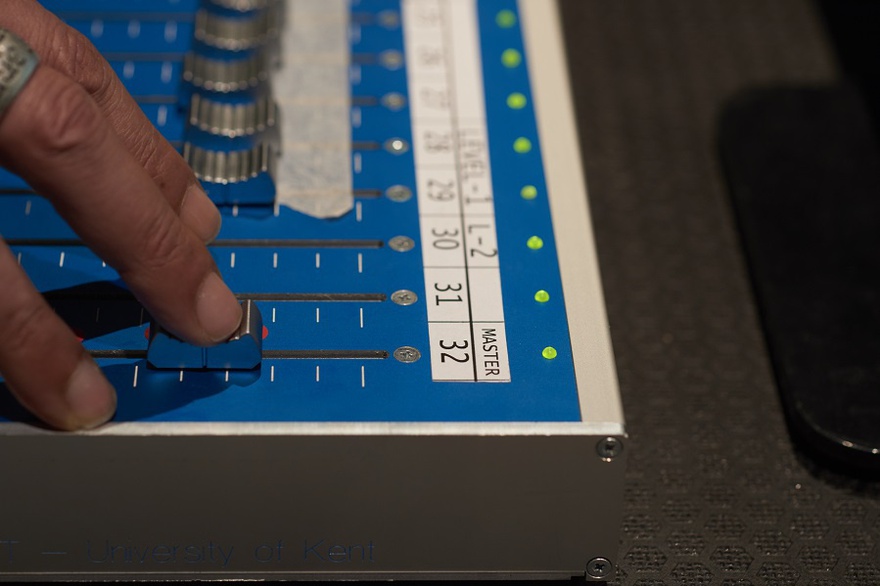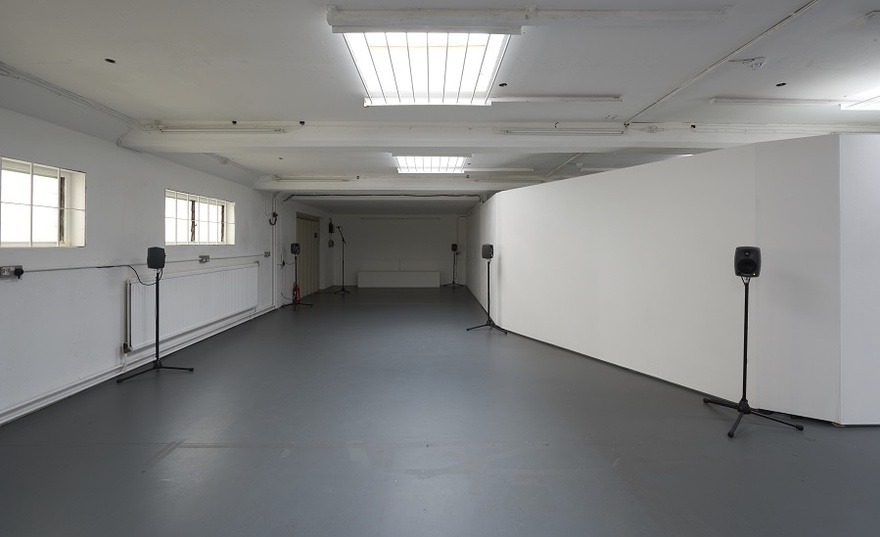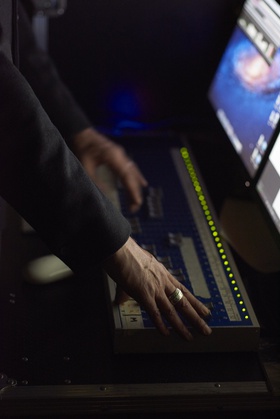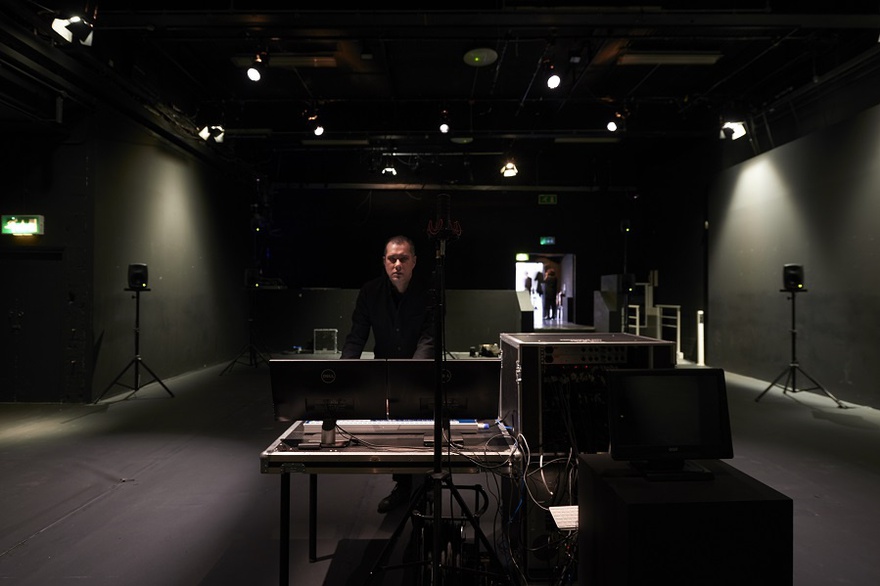Interviews
The Islamic Sonic-Social
Seth Ayyaz in conversation with Sheyma Buali
This interview examines aspects of the work of sound artist, composer and theorist, Seth Ayyaz. The starting point in Ayyaz's sound work refers to the bio-psycho-social conditions of listening that draw on his background in cognitive neuroscience and psychoanalysis. Using Islamic sonic performance as a prism, Ayyaz touches on the social domain, ethnic minorities in the greater Muslim world, and the changing geopolitics of the region today.
The interview is broken into three parts. In the first, Ibraaz Commissioning Editor Sheyma Buali breaks down the artist's ideas on 'the Islamic sonic-social' by unearthing theories behind three of his compositions: Makharej (2009), The Remainder (2013), and the bird ghost at the zaouia (2010), which together form a triptych titled On The Admissibility of Sound (2015). This is followed by part two of the interview: a short discussion between Ayyaz and artist and writer Lisa Skuret, thinking through expanded notions of listening. The final section is an edited transcript of a panel discussion that took place as part of Ayyaz's week-long exhibition in December 2015 as part of the fig-2 50-week series at the Institute of Contemporary Art in London, Listening Through a Beam of Intense Darkness.
Part 1
In Part 1 of this interview Seth Ayyaz talks about the ideas behind his triptych On the Admissibility of Sound, three electroacoustic pieces in the fig-2 exhibition, Listening through a Beam of Intense Darkness, that deal with different aspects of the Islamic Sonic Social. Ayyaz performed a live mix of the three pieces, Makharej, The Remainder and the bird ghost at the zaouia over a 32-channel MAAST sound system, making use of field recordings from Muslim cities of the Middle East, North Africa and South Asia (MENASA) region.In all three pieces contemporary electroacoustic techniques of sound synthesis and spatialization are brought to bear on 'traditional' Islamic musical concerns such as the recitation of Qur'an, the adhan (call to prayer), the admissibility of music, the number theory applied to maqammat (pitch) and iqaat (rhythm).In short,Ayyaz discusses the performance of pronunciation, power plays and sonic permissibilities in the Islamic world. An excerpt from the convert can be viewed on the Ibraaz Channel here.
Sheyma Buali: Can you introduce the idea of what you call the 'Islamic sonic social'?
Seth Ayyaz: My notion of the 'Islamic sonic social' tries to capture the idea that sound is both constitutive of, and constructed by, social processes amongst other things. Contextually, that can be specifically understood in relation to Islamic historical, cultural and religious practices and ideas. As an example, the anthropologist Charles Hirschkind has described what he calls the 'aesthetically tuned sensorium', where listening to sermons and Qur'anic texts instills a kind of piety in the listener. Another example would be the function of the adhan. This can be considered a potent marker of unified difference and power. But of course there are many Islamic sonic socials: I don't think it is simply one thing. As you know, Rabat is different to Cairo, which is different to Istanbul, or Abu Dhabi and so on.
The context here is my experience of growing up as a British-Mauritian Muslim and this will be common with other non-Arab Muslims: you grow up with a notional or idealized idea of Islam that references the Arab world. Thus, it made sense for me to engage with current geopolitical contexts, from the 9/11 attacks to all that is going on now, including the so-called Arab Spring. The three electroacoustic pieces in the fig-2 exhibition, Listening Through a Beam of Intense Darkness, deal with different problematic aspects of my relationship with Islam, but it does not stake any personal claim on offering an Islamic perspective.
Sh.B: Before getting into the specifics of each piece, could you tell us about the theory of electroacoustics that you work with?
SA: There are traditions in electroacoustic music, including the school of thinking from Pierre Schaeffer and musique concrète, about the use of sound objects. You are supposed to 'bracket out' the causality of the sound and hear it 'in-itself', with its own particular shape. Schaeffer says that we gain a kind of objectivity in doing so. I reject this position because it strips the sound from any reference and meaning. My approach is rather different. While I use sound objects from the real world and apply electroacoustic practices to them, I am much more interested, conceptually, in what that object is, how it is embedded within the process as event, and its multiple associations. These then become sites for intervention. I intervene into adhan, Qur'anic recitations, or instrumental sounds from traditional instruments like the qanun, ney or daf. Whatever these sounds are, by processing them and using various techniques that change and transform them, it becomes an implicit critique on the sound and its provenance.
Sh.B: In a way, you are agitating the sounds.
SA: Both politically and perceptually, there are layers to this agitation that I am interested in. There is a play between familiarity, unfamiliarity and awareness. For example, taking a single letter in Makharej, or taking a bird sound in the bird ghost at the zaouia, and applying different transformations to them creates a family of related sounds, some of which sound close to the original. But over time, and through using different techniques, they become more and more unfamiliar, almost remote. I am very interested in that play between the familiar and unfamiliar, or the known and the not-as-yet-known – not just as sounds, but in the political sense, socially: what is alien, what is domestic, what are we comfortable with.
Sh.B: Your piece, Makharej, has, at its core, a vocal performance that examines the 28 letters of the Arabic alphabet. You caption this as 'voice featuring vocal body'. Can you talk a bit about the role of the body here and annunciation as performance?
SA: Amira Ghazalla is a fantastic Egyptian performer and actress who has researched the embodiment of Arabic and of Qur'anic recitation. She also worked in the experimental theatre scene of 1980s Berlin and so was a perfect choice for this compositional project. Makharej is the place from which the letter is articulated; we pronounce from the 'makhraj'. It refers to the idea of an ideal and correct pronunciation, which links to the divine authority of the language. But there is also something about the body that produces that sound; it was the material basis of its production that interested me. Using microphone and studio techniques it is possible to investigate in detail how or where it was pronounced from: the diaphragm, the nose, back of the throat, or the front of the teeth, for example. Using the microphone almost forensically, you can magnify tiny details and create a kind of hyper-reality.
With Makharej, we hear each letter pronounced in the 'correct' articulation but from multiple degrees of sonic perspectives. The electroacoustic processing is often subtle, intervening inside these sounds, but creating impossible embodiments that are picked up by the listener unconsciously. For example, exhaling followed by exhaling, extensions of vowels that are not possible to physically produce, and so on. The piece also draws from European sound poetry like Henri Chopin, or Kurt Schwitters. There is an idea of freedom in taking a letter and making it something else. It can be misshaped, mispronounced and so on, which implicitly challenges the 'correctness' of pronunciation and ownership of this language – it can be contested, it can be argued over, and it can be multiple. Even within the Arabic world there are so many different dialects and different kinds of pronunciation. Fusha is one form, but a Moroccan trying to speak to a Qatari may have a problem. There is a plurality there.
The ideas behind the piece are to investigate the assemblage of sound through a multiple perspective on the material body (or bodies) and to both investigate Arabic letters and to ask questions about them, what they can do, and what they might be. There is, of course, a 'political' subtext: a contesting of our current tragic state of outmoded monolithic ideologies whether they be Imperialism, Islamo-fascism or another stripe of stupidity.
Sh.B: This combination – your study of 'correctness' with your subsequent electroacoustic and digital processing – refers to your ideas on foreignness, familiarity and the divine. Can you explain the political subtext behind this?
SA: I am challenging the monochromic idea of reductive 'correctness'. In the Islamic traditions of tajwid (conventional system of rules governing the recitation of the Qur'an) and tilawa (ritual Qur'anic recitation) the words and letters are pronounced in a particular way. This is intended to assure the divine correctness of the aural transmission of the text to ensure it does not become 'deformed' as it is passed along. This embodies authority. However, paradoxically, in its worst and most reductive authoritarian forms (such as what we are seeing at the moment with ISIS and Wahabbism and so on) this 'correctness' is a stifling Puritanism that is hostile to thought and creativity. So by imaginatively playing with the letters, Makharej isa kind of challenge through a practice: an ethical stance that many of us from Islamic culture will recognize. The 'correctness' is a question, and turns out to be a multiplicity of possible forms.
In each letter, Amira gives the 'correct' pronunciation: with a Cairene accent! What happens afterwards is anything but correct. The letter snakes off, slips and slides through the body and out into the world in other kinds of forms. It starts to glitch and fragment and join with elemental electronic sound. Implicitly there is a tension within and around this body.
Sh.B: In one piece you do not use any music, and you mention that came out of respect towards Muslim clerics that you came across. Why is it that music is frowned upon in Islam, or Islamic sound practices? And how did you incorporate this divide in your work?
SA: bird ghost of the zaouia came about through my travels across the MENASA region: mostly Morocco, Egypt, Lebanon and Syria. I was partly there to learn music as a nay and daf player but I was also making field recordings of the environment that I was in. I became interested in the Sharia debates on the permissibility of music, which has its roots in Al Ghazali's 11th century text on listening to music. He talks about music as virtue or poison depending upon each musician's intentions, purposes and moral purity.
There is an idea of sound as something contagious that has its effects for good or for ill. Music is powerful and has a moral dimension. Historically, music was associated with the slave girl and bawdiness. There are the famous references in the hadith about the prophet and whether or not he liked music. In Morocco, music – with established Sufi ideas – is prayerful, joyful and very much part of the culture. It is the same in Egypt. But by contrast, in the Gulf and Saudi Arabia in particular, there also is a suspicion and injunction against sound and music. The permissibility of music under different schools of Islamic law is a well-known debate, dubbed by Kristina Nelson in 2001 as 'the sama' polemic'. In brief, two poles operate – a (broadly) Sufi perspective that argues for music (under the right conditions) as spiritual and prayerful practice, and a puritanical perspective, which holds that music of any kind is intrinsically blasphemous and an invitation to sin. I became very interested in this division. So when making field recordings in mosques and other religious places, a frequent question was 'what are you going to do with these recordings?' The sheikh, or whoever was asking me, would be happy with me making the recordings as long as I wasn't going to present it as music.
But how do we construct this division between what is and is not music? To a western ear, even the adhan sounds musical. But if you ask a muezzin, they are going to tell you very clearly that this is not music. I started chopping out the sections that may be regarded as music according to different debates and then leaving just the reverberation or incidental, environmental and interstitial sounds that I found in these spaces. These became the starting point of bird ghost of the zaouia and my investigation between sound and music and their permissibility.
Sh.B: Beyond the implication of accents, you speak about soundscapes as an identifying factor of place. Earlier, when introducing the idea of the Islamic sonic social, you mentioned sound's role in community and the control and power at play.
SA: One obvious example is the adhan as a disciplining force among a population. Five times a day it imposes a kind of rhythm. Anyone who has grown up in that kind of context understands that very clearly. Sound in that sense is a disciplining presence that is heard and, in a sense, controls. There are differing perspectives on this sound: some people see it as a great liberation; as being part of a brotherhood and sisterhood that signals getting together for the mosque; and having a certain kind of regulation. But of course, for many people that is not the case. It becomes oppressive: a form of propaganda. And, of course, Friday sermons are often politically charged. To me, that context of sound is a way of addressing multiple people and organizing people's thoughts, feelings and behaviours.
Sh.B: The presence of the adhan goes a step further with their inclusion into everyday life through its digitization – people have it on their phones as alarms for prayer times or as ring tones. There is also an issue of volume – in Bahrain, for example, there is a volume war between the mosques in Ma'atem. In today's climate that is a political gesture.
SA: The anthropologist Charles Hirschkind, who I mentioned earlier, has written a lot about sound and this context. He talks about the dissemination of cassettes and recorded sermons or the 'ethically honed sensorium'. This has a lot to with new Islamic politics in that the idea of piety is inscribed in these cassettes and listening to these cassettes is, in its own right, a form of piousness. It happens in a very benign way at times – in Cairo, for example, I would get into the taxi and the driver would chat away but in the background you would hear this faint Qur'an recital. It is not a malevolent thing, it is very ubiquitous, but it can get picked up and politicized and articulated to the point where we are now.
What I hope to do is draw people into the awareness of sound and into listening. One of the issues is that it is so submerged in the background and it is so pervasive that we don't question or think about it. I am more interested in bringing into focus the fact that there are these sounds that function in particular ways and that have potential propagandist aspects. They also have positive aspects. I became intrigued by the presence of these sounds, distributed in the way that they are, and wanted to know how I could draw people's awareness into these presences.
Part 2
On 5 December 2015, artist and writer Lisa Skuret held a workshop as part of the exhibition Listening Through a Beam of Intense Darkness. The workshop, entitled 'Messy and Material: Listerning Laboratory', focused on listening as a multi-sensory act and as a group process. Here, Skuret and Ayyaz discuss communal, spatial and embodied associations of listening across their respective work.
Seth Ayyaz: There are a number of things about how our work relates, specifically regarding the sounds from the Middle East, Islamic cultures, and interrogating and investigating these sonic places and their markers of cultural identities. Your work extends from listening as an active process; listening as an action that happens in the inter-subjective space. Listening happens in between people and between groups of people and emerges from it. For example, in Morocco, the presence of music on the streets means that everyone is involved and can join in. There is not necessarily a hierarchy of involvement and everybody can be implicated. It is something that just starts to emerge from a matrix between people.
Lisa Skuret: Absolutely, there are processes that reinforce areas of identity, but it is also about trying to generate new forms through the listening. My work with expanded notions of listening is concerned with possible futures and with generating these futures communally.
SA: It is a way of dissolving the traditional notion of 'subject' and 'listener' into something that happens in an emergent way between people and through material objects.
LS: Yes, and also listening in a different way. We are culturally and individually habituated to listening in certain ways. I am interested in listening (and the listener) as a process of not-knowing and raising questions rather than knowing answers. In that way, we can consider not-knowing as un-doing or un-knowing: learning to listen in new ways.
SA: There is something about the way people explore this subjective space between one another that joins people together through these processes of intuition and empathy.
LS: And resistance. But working with groups can be problematic, especially considering the political situation we are in today. Posing difficult questions in a group context raises various issues. So listening also relates to resistance in terms of resisting change but also, perhaps more productively, resisting habitual ways of thinking.
SA: This idea of 'not-knowing' is something I would like to pick up on because there is a peculiar and interesting set of attitudes or, as you say, habits attached to this. For example, in the bird ghost at the zaouia and through studying classical Arabic music, a set of attitudes about listening and acting are tied to ethics. There is this idea of what is permissible in Islam, and there are these ideas on correctness, which we spoke of before. Take something like the adhan or the sound of a particular place: it is like a transparent index of a place, which seems familiar and almost oversaturated with meaning. They are 'emblematic' of a certain culture.
But, to me, there is something about intervening with that electroacoustically and translating these actor-object-sounds in different ways that takes that previous state of knowing to a place where you have questions. It starts to loosen up certainties about what you are hearing, how you are hearing, or what it may signify and the associations that the sounds may have. I am very interested in using sounds that are charged. It is about taking certainty and problematizing it.
LS: There is a connection between your work Makharej asan interrogation of the Arabic alphabet and our collaboration A Call from the Library (2014). Musicologist Zeynep Bulut refers to attempts to build a new voice through the process of our collaborative piece, and I think this also applies to Makharej. One needs familiarity and certainty; one needs to know how to navigate. So what do you do with that new construction, that unknown voice, that new composition?
SA: Yes, I would agree. This laboratory has also shown the intersection of our theoretical approaches. What strikes me about your work is that listening seems to be one sensory channel into wider thoughts on knowledge production.
LS: Sound affects our bodies and our awareness. Our bodies resonate and listen. We tend to perceptually filter out 'unuseful' sounds but we embody them and they influence our actions. The adhan is one example – if you live in a culture where it is part of your everyday reality, you may not question how these unattended sounds infiltrate everything or how they affect you physically. Not just the literal meaning conveyed through the medium of sound, but also the affects they have on your movements and agency. I speak of this in relation to my work, but this also relates to the process of making your piece, the bird ghost at the zaouia, which is based on field recordings from various religious rituals across the region.
SA: Here you are talking about the affective reaction a person has to sound, but I guess what I am asking about is the way you are trying to activate that type of contagion without using sound.
LS: Listening is multi-modal. I think that actively enlisting agency in our listening highlights the awareness and potential of this multi-modality.
SA: It highlights an introspective process.
LS: I think that concentration is like a 'travelling ear'. For example, it is often difficult to listen to one sound in particular without eventually finding yourself back in internal monologue. One of the exercises in my laboratory was listening to and following an environmental sound as it osculates between external dialogues and internal monologue. In following a sound, the sound's 'logical conclusion' may be experienced as a sensation and this sensation may, in turn, manifest communally in the group matrix as a feeling.
PART 3
This discussion took place as part of Listening Through an Intense Beam of Darkness and involved Seth Ayyaz, musicologist and performer Zeynep Bulut; composer and theorist Erik Nyström; artist and writer Lisa Skuret and fig-2 curator Fatos Ustek. Through the scope of sound theory, they discuss issues of cognitive opacity and translucency and argue the subjective response to sound.
The following is an edited transcript of this talk. You can hear the full discussion here.
Fatos Ustek: It feels like there are three strands of listening. There is the strand that is the registry of subjectivity. There is also the strand of the musicality of sound. The third strand is the possibility of listening as a subject within the constellation of our brain and our consciousness. Can we really tune in to the sounds as they are or is it as if we hear the shadows of what these sounds might be?
Seth Ayyaz: Embedded within the title Listening Through a Beam of Intense Darkness are two constellations of thought that address how we might think about listening.
Firstly, the psychoanalyst Wilfred Bion spoke about listening with no memory, no desire or understanding – so suspending preconceptions. He described a beam of intense darkness through which objects can be illuminated. He talked about the unconscious charge that these objects carry in some way.
Secondly, the neurophilosopher Thomas Metzinger is relevant. Electroacoustic composition tends towards highlighting the listener and listening but, to my mind, usually fails to formulate the conditions that give rise to both. Metzinger resurrects philosophical notions of cognitive and phenomenal 'transparency' versus 'opacity'. He describes the window of consciousness: we cannot introspect into the nature of that window because we are usually unaware of the window itself, we only see transparently through it. So when we hear sound, we may assume it to be part of the world and experience it as transparently real. By contrast opacity is the clouding of that transparency, the awareness of being in a representational process. When our central executive, the attentional networks of our brain, are engaged by something that has salience – for example aural perception is problematized by something anomalous – we are drawn into reflective processes: our phenomenal experiences become more opaque to us.
FU: Zeynep, you are a performer and a scholar. How do you relate to this concept of listening?
Zeynep Bulut: I have been intrigued by a variety of things in this conversation. I'm a practitioner but more of a scholar. So what I have been thinking about with these three pieces [performed at the concert] is the composition of sound in the way that I imagine in my own practice. I am reminded of how I learned to listen to certain sounds, my own habits and my own situated practices of listening – so, how I bring my ear to a certain sound and why.
For instance, coming from Turkey, I often pick up on the adhan or the different sounds that may remind me of that location. But as a vocalist and someone who writes about sound poetry, I really attuned to the production of punctual sounds, the sound of the consonants and how they punctuate space in Makharej. So there is a personal recollection of sound but also a particular way of learning how to listen and produce.
FU: It is also interesting that techniques and forms of listening proliferate according to the listeners and their associations with the sounds. They amplify our own attunements. It's not only our cultural registers that comply but also the sounds and smells that we grew up with that have a liberation.
I am struck by the neuroscientific fact of listening being constructed based on 14 seconds of recent memory so that we are not just calling back the immediate past of what was heard but also a moment layered with our own past experiences. I want to bring Erik in here. These positions are also interesting to the concept of surfaces and textures as a composer. How do you compose the product and the act of listening? Do these collide and intersect or are they parallel planes?
Erik Nystrom: I consider listening to be a multi-level activity – though personal, the experience activates all dimensions of consciousness. I think texture, in particular, has a very strong presence in that kind of environment because texture is something that we know from different modes of perception: visual texture, tactile texture. On a more conceptual level it is very interesting, particularly the texture of space itself and how we see space warp over time. That is something that you have in immediate, day-to-day experience – orienting yourself around the world but also looking at it from a cosmic dimension. If you look at the scientific discipline of cosmology or quantum mechanics, you end up with the fabric of space or texture. For me as a listener, one aspect is that it is an object within many objects, a surface among many surfaces, a magnet of perceptual elements. In that sense it is an emergent process. There is a limit to perception – we cannot perceive all the elements in the sound but we can perceive the surface. And that relates to how sound is organized and how music is structured generally.
SA: I agree. Linking back to Fatos's introduction I question the notion of subject and subjectivity in constructing that textural surface. I believe we are burdened by what Meillassoux terms 'correlationism' and the Kantian legacy where we think of listening as transcendent, which is very problematic. It is not just the sound that is emergent but the self that is said to have such an experience, too. This has implications for subjectivities, as unstable and multiple things that could be otherwise. Listening is not the reception of a world by a transcendent given self. Listening goes beyond the receptive and is an active exploratory behaviour. Auditory neuroscience demonstrates the auditory cortex as not limited to the passive reception of sound, but as having memory and predictive cognitive capacities. It is not just receiving but rather actively constructing in multiple ways. A self is partially produced through the act of listening.
FU: There are two things here. Maybe we can contest this idea of subjectivity, but at the same time, through the commonalities of inhabiting a space there is a trace of communal behaviour-isms towards the sounds we are surrounded by – the reflective responses.
SA: Again, I am not sure about this traditional division between self and other. In social neurocognitive terms we actually share spaces, through what Gallesse calls the shared manifold of intersubjectivity. We represent interior motivations, intentions and desires of our self in the same space as others.
LS: That is why I am interested in working in groups. Different groups will be accustomed to listening to certain things and in certain ways. Groups, not individuals, are the basic form. We construct realities together through group process. Cultural and individual habits and rules tend to reinforce and inform pre-existing maps. But working with and, in effect, rewiring the group matrix also points to potential ways out.
SA: Yes. I think of listening, interpreting and acting as a triple helix, all winding around each other. They are constantly working together. There is something about not understanding that carries the act of interpreting with it.
EN: Also, in these kinds of experiences where you become aware of the limits of your psychological, cognitive and physiological ability to process sound, you start to hear distortions and sound that you can't compute. That is actually the situation where you become aware of the window.
SA: Yes, I agree, these concerns inform my compositions such as Makharej and the bird ghost of zaouia. There is a play with the psychoacoustic limits of listening and the transformations of materials using details and frequency patterns that can't be resolved, and the creation of acoustics that can't exist in space itself.
Seth Ayyaz is a London based composer-performer, writer and occasional curator, who draws on psychiatry, neuroscience and sound art, refracted through extensive engagement with contemporary Middle Eastern experimental music. His sound work spans installation, live electronics, improvization, noise, electroacoustic and Arabic music. His work is concerned with (dis)embodied perceptions and how these resonate across psychological and social spaces. His main focus is on listening – and investigating what a sonic assemblage can do. Specializing in live electronics and machine-listening, Ayyaz builds custom performance ecologies for specific situations. Another key focus is between 'Occident' and 'Orient', critically exploring the legacies of Islamic cultures (music, mathematics, medicine, literature and alchemy) that have been effaced in traditional Western historical accounts. Ayyaz's work offers counter-narratives to current metaphors of cultural exchange and hybridity, instead foregrounding issues of friction, displacement and translation.
Ayyaz has presented his work internationally including at Cafe Oto, London; Kunsthalle Luzern, Switzerland; Irtijal Festival, Beirut; Maerz Music, Berlin; the World Forum for Acoustic Ecology, Finland; and the Haus Für Elektronische Künste, Basel. Ayyaz also writes on sound and has been published in The Wire, Organised Sound, and most recently in On Listening (edited by Angus Carlyle and Cathy Lane). His live work includes the Usurp Chance Tour 2014 – Cage and Beyond, produced by Usurp Art Gallery in partnership with Sound and Music. He curated the MazaJ Festival of Experimental Middle-Eastern Music, London, 2010, supported by Sound and Music, City University London and The Wire.
Lisa Skuret is an artist and writer based in London. Skuret's work researches knowledge production through an interdisciplinary practice combining live and site responsive work, text, score, performance, sound, installation and workshops. Recent work has taken place throughout a former public library; a Swedenborgian Church after service; Museum of Work, Sweden; Spike Island, Bristol; PEER Gallery, London; Parasol Unit, London; David Roberts Art Foundation, London; and MoMA PS1 in New York. Skuret is currently working on the project Communal Materials; Or, Evolution Isn't Fast Enough, which is supported by an Arts Council England award (2014–15). Recent work as part of this project includes A Call from the Library (2014), a performance installation 'listening to' and 'playing' a former public library in which the 'score' was the former public library itself.
Erik Nyström is a composer whose output includes electroacoustic works, live computer music, and sound installations. The majority of his works are composed for multichannel systems. Some recurring aesthetic and conceptual themes in his practice are spatiotemporal deformations and transformations, textural topology, morphogenesis, entropic processes, and visual and physical listening experiences. He is currently a Leverhulme Research Fellow at BEAST (Birmingham Electroacoustic Sound Theatre), University of Birmingham Department of Music, working on a project entitled Synthesis of Spatial Texture Topology in Composition and Performance. The research develops polymorphic realtime synthesis approaches to spatial texture and structuring processes, proposing an aesthetic and technological alternative to conventional fixedmedia composition and diffusion performance in electroacoustic music. His music has been published by empreintes DIGITALes.
Zeynep Bulut is a lecturer in music at King's College, London. Prior to joining the music department at King's, she was a research fellow at the ICI Berlin Institute for Cultural Inquiry (2011–13). She received her Ph.D. in Critical Studies/Experimental Practices in Music from the University of California at San Diego in 2011. Situated in the fields of voice, experimental music and sound studies, her scholarly and creative work examines the emergence, embodiment and mediation of voice as skin.
Fatos Ustek is an independent curator and writer based in London. She was the Art Fund curator at fig-2, a visual arts programme of 50 weeks composed of 50 projects that launched at ICA Studio on 5 January 2014. Ustek is associate curator for the 10th Gwangju Biennale in South Korea, member of AICA Tr and regular contributor to international art magazines and catalogues. She is a core member of artistic research group OuUnpO and leads research projects La Duree with Per Huttner under the framework of Vision Forum.

